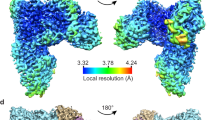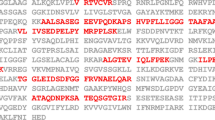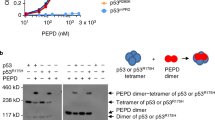Abstract
Human papillomavirus (HPV) type 16 and 18 E6 proteins target many of their cellular substrates for proteasome-mediated degradation. In the case of p53, this is mediated by the E6AP ubiquitin ligase. However it is still unclear whether other E6 substrates, in particular those containing PDZ domains, are also degraded in a similar manner. To investigate this, we established an epithelial cell line from E6AP-null mice and used these cells as a background to perform E6-mediated in vivo degradation assays. We show that the PDZ domain-containing substrates of E6, including Scribble, MAGI-1 and MAGI-3, are all subject to E6-mediated degradation in these cells. Strikingly, we also found that p53 could be degraded by E6 within these cells in a proteasome-dependent manner. These results demonstrate that HPV-16 and -18 E6 can target substrates for degradation in a manner independent of the E6AP ubiquitin ligase.
This is a preview of subscription content, access via your institution
Access options
Subscribe to this journal
Receive 50 print issues and online access
$259.00 per year
only $5.18 per issue
Buy this article
- Purchase on Springer Link
- Instant access to full article PDF
Prices may be subject to local taxes which are calculated during checkout




Similar content being viewed by others
References
Camus S, Menendez S, Cheok C, Stevenson L, Lain S, Lane D . (2007). Ubiquitin-independent degradation of p53 mediated by high-risk human papillomavirus protein E6. Oncogene 26: 4059–4070.
Cooper B, Schneider S, Bohl J, Jiang Y, Beaudet A, Vande Pol S . (2003). Requirement of E6AP and the features of human papillomavirus E6 necessary to support degradation of p53. Virology 306: 87–99.
Gardiol D, Banks L . (1998). Comparison of human papillomavirus type 18 (HPV-18) E6-mediated degradation of p53 in vitro and in vivo reveals significant differences based on p53 structure and cell type but little difference with respect to mutants of HPV-18 E6. J Gen Virol 79: 1963–1970.
Gardiol D, Kühne C, Glaunsinger B, Lee SS, Javier R, Banks L . (1999). Oncogenic human papillomavirus E6 proteins target the discs large tumour suppressor for proteasome-mediated degradation. Oncogene 18: 5487–5496.
Glaunsinger B, Lee S, Thomas M, Banks L, Javier R . (2000). Interactions of the PDZ-protein MAGI-1 with adenovirus E4-ORF1 and high-risk papillomavirus E6 oncoproteins. Oncogene 19: 5270–5280.
Grm H, Banks L . (2004). Degradation of hDlg and MAGIs by human papillomavirus E6 is E6-AP-independent. J Gen Virol 85: 2815–2819.
Hengstermann A, D'Silva M, Kuballa P, Butz K, Hoppe-Seyler F, Scheffner M . (2005). Growth suppression induced by downregulation of E6-AP expression in human papillomavirus-positive cancer cell lines depends on p53. J Virol 79: 9296–9300.
Huibregtse J, Scheffner M, Howley P . (1993). Cloning and expression of the cDNA for E6-AP, a protein that mediates the interaction of the human papillomavirus E6 oncoprotein with p53. Mol Cell Biol 13: 775–784.
Jiang Y, Armstrong D, Albrecht U, Atkins C, Noebels J, Eichele G et al. (1998). Mutation of the Angelman ubiquitin ligase in mice causes increased cytoplasmic p53 and deficits of contextual learning and long-term potentiation. Neuron 21: 799–811.
Kelley M, Keiger K, Lee C, Huibregtse J . (2005). The global transcriptional effects of the human papillomavirus E6 protein in cervical carcinoma cell lines are mediated by the E6AP ubiquitin ligase. J Virol 79: 3737–3747.
Kiyono T, Hiraiwa A, Fujita M, Hayashi Y, Akiyama T, Ishibashi M . (1997). Binding of high-risk human papillomavirus E6 oncoproteins to the human homologue of the Drosophila discs large tumor suppressor protein. Proc Natl Acad Sci USA 94: 11612–11616.
Latorre IJ, Roh MH, Frese KK, Weiss RS, Margolis B, Javier RT . (2005). Viral oncoprotein-induced mislocalization of select PDZ proteins disrupts tight junctions and causes polarity defects in epithelial cells. J Cell Sci 118: 4283–4293.
Lee C, Laimins L . (2004). Role of the PDZ domain-containing motif of the oncoprotein E6 in the pathogenesis of human papillomavirus type 31. J Virol 78: 12366–12377.
Lee S, Glaunsinger B, Mantovani F, Banks L, Javier R . (2000). Multi-PDZ domain protein MUPP1 is a cellular target for both Adenovirus E4-ORF1 and high-risk papillomavirus type 18 E6 oncoproteins. J Virol 74: 9680–9693.
Lee S, Weiss R, Javier R . (1997). Binding of human virus oncoproteins to hDlg/SAP97, a mammalian homolog of the Drosophila discs large tumor suppressor protein. Proc Natl Acad Sci USA 94: 6670–6675.
Liu Y, Chen J, Gao Q, Dalal S, Hong Y, Mansur C et al. (1999). Multiple functions of human papillomavirus type 16 E6 contribute to the immortalization of mammary epithelial cells. J Virol 73: 7297–7307.
Munger K, Basile J, Duensing S, Eichten A, Gonzalez S, Grace M et al. (2001). Biological activities and molecular targets of the human papillomavirus E7 oncoprotein. Oncogene 20: 7888–7898.
Nakagawa S, Huibregtse J . (2000). Human scribble (Vartul) is targeted for ubiquitin-mediated degradation by the high-risk papillomavirus E6 proteins and the E6AP ubiquitin-protein ligase. Mol Cell Biol 20: 8244–8253.
Nguyen M, Nguyen M, Lee D, Griep A, Lambert P . (2003). The PDZ ligand domain of the human papillomavirus type 16 E6 protein is required for E6's induction of epithelial hyperplasia in vivo. J Virol 77: 6957–6964.
Pim D, Thomas M, Javier R, Gardiol D, Banks L . (2000). HPV E6 targeted degradation of the discs large protein: evidence for the involvement of a novel ubiquitin ligase. Oncogene 19: 719–725.
Scheffner M, Huibregtse J, Viestra R, Howley P . (1993). The HPV-16 E6 and E6-AP complex functions as a ubiquitin-protein ligase in the ubiquitination of p53. Cell 75: 495–505.
Scheffner M, Werness B, Huibregtse J, Levine A, Howley P . (1990). The E6 oncoprotein encoded by human papillomavirus types 16 and 18 promotes the degradation of p53. Cell 63: 1129–1136.
Shai A, Brake T, Somoza C, Lambert PF . (2007). The human papillomavirus E6 oncogene dysregulates the cell cycle and contributes to cervical carcinogenesis through two independent activities. Cancer Res 67: 1626–1635.
Storrs CH, Silverstein SJ . (2007). PATJ, a tight junction-associated PDZ protein, is a novel degradation target of high-risk human papillomavirus E6 and the alternatively spliced isofcrm 18 E6. J Virol 81: 4080–4090.
Thomas M, Kalita A, Labreque S, Pim D, Banks L, Matlashewski G . (1999a). Two polymorphic variants of wild-type p53 differ biochemically and biologically. Mol Cell Biol 19: 1092–1100.
Thomas M, Laura R, Hepner K, Guccione E, Sawyers C, Lasky L et al. (2002). Oncogenic human papillomavirus E6 proteins target the MAGI-2 and MAGI-3 proteins for degradation. Oncogene 21: 5088–5096.
Thomas M, Massimi P, Navarro C, Borg J-P, Banks L . (2005). The hScrib/Dlg apico-basal control complex is differentially targeted by HPV-16 and HPV-18 E6 proteins. Oncogene 24: 6222–6230.
Thomas M, Pim D, Banks L . (1999b). The role of the E6–p53 interaction in the molecular pathogenesis of HPV. Oncogene 18: 7690–7700.
zur Hausen H . (1996). Papillomavirus infections—a major cause of human cancers. Biochim Biophys Acta 1288: F55–F78.
Acknowledgements
We are grateful to Miranda Thomas for comments on the manuscript. This work was supported in part by a research grant to LB from the Associazione Italiana per la Ricerca sul Cancro and to PL from the National Institutes of Health (CA098428, CA022443).
Author information
Authors and Affiliations
Corresponding author
Rights and permissions
About this article
Cite this article
Massimi, P., Shai, A., Lambert, P. et al. HPV E6 degradation of p53 and PDZ containing substrates in an E6AP null background. Oncogene 27, 1800–1804 (2008). https://doi.org/10.1038/sj.onc.1210810
Received:
Revised:
Accepted:
Published:
Issue Date:
DOI: https://doi.org/10.1038/sj.onc.1210810
Keywords
This article is cited by
-
A Review Study of the Impact of Plant Extracts on Viral Infections Like HPV and Cervical Cancer
Indian Journal of Gynecologic Oncology (2024)
-
Targeting PDZ domains as potential treatment for viral infections, neurodegeneration and cancer
Biology Direct (2021)
-
Involvement of Tight Junction Plaque Proteins in Cancer
Current Pathobiology Reports (2016)
-
HCV NS4B targets Scribble for proteasome-mediated degradation to facilitate cell transformation
Tumor Biology (2016)
-
Roles of the PDZ domain-binding motif of the human papillomavirus type 16 E6 on the immortalization and differentiation of primary human foreskin keratinocytes
Virus Genes (2014)



